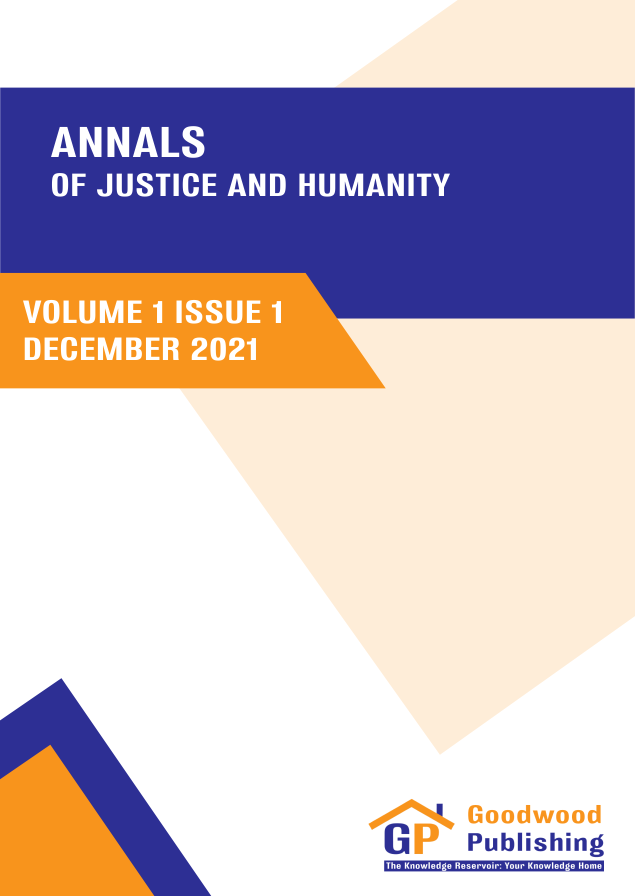Shift in the role of criminology in criminal law: Reflecting the doctrinal change
Abstract:
Purpose: The study's aim is to assess how criminology's role in criminal law has changed over time. In addition, the author suggested that criminology can be used to test and suggest explanatory theories for criminal law rather than doctrinal shifts.
Research methodology: The authors use literature-based observational analysis to assess how criminology's role in criminal law has evolved. Methodical investigation of logical literature uncovered the shift in the role of criminology in criminal law.
Results: The authors claim that doctrinal changes have shifted perceptions of criminality, but the study's findings suggest otherwise. Doctrine changes mysteriously and without judicial acknowledgement, revealing shifting facts and suggests that the role of criminology in criminal law may be changing.
Limitations: Even after a doctrinal shift, the authors argue, having criminological theories and perspectives helps assign proper rules to criminal law.
Contribution: The study's findings support the often-criticized objectivist view of criminology but disagree on the subjectivist view of doctrine shifts. This study suggests that a new field will emerge that transcends both criminology and criminal laws rather than doctrine changes.
Downloads
Agnew, R. (2005). Why do criminals offend?: A general theory of crime and delinquency.
Agnew, R. (2006). Pressured into crime: General strain theory. Criminological theory: Past to present, 4, 189-197.
Conrad, J. P., & Myren, R. A. (1979). Two views of criminology and criminal justice: Definitions, trends, and the future.
Calvelli and Ciglio v. (2002). European Court of Human Rights [ECHR]. Grand Chamber [ECHR]. Italy.
Farrington, D. P. (2010). Life-course and developmental theories in criminology. The Sage handbook of criminological theory, 249-69.
Khan, M. M. R. (2020a). Strategic human resource management in facilitating the organizational performance: Birds-eye view from Bangladesh. Annals of Management and Organization Research, 2(1), 13-24.
Khan, M. M. R. (2020b). Covid-19’s impact on Fresh Graduate’s Job Market in Bangladesh: An observational study. Journal of Business and Management Studies, 2(1), 40-48.
Khan, M. M. R. (2021). Women and Sports: View from Stereotyping and Gender Differentials Perspectives. Journal of Sports and Physical Education Studies, 1(1), 01-04.
McGuire, J. (2004). Understanding psychology and crime: Perspectives on theory and action. McGraw-Hill Education (UK).
McLaughlin, E., & Newburn, T. (2010). The sage handbook of criminological theory.
Moffitt, T. E. (1993). Adolescence-limited and life-course-persistent antisocial behavior: a developmental taxonomy. Psychological review, 100(4), 674.
Muftić, L. R. (2009). Macro-Micro Theoretical Integration: An Unexplored Theoretical Frontier. Journal of Theoretical & Philosophical Criminology, 1(2).
Newburn, T. (2007). “Tough on crime”: penal policy in England and Wales. Crime and Justice, 36(1), 425-470.
Walsh, A. (2010). Biology and criminology: The biosocial synthesis. Routledge.
Webber, C. (2009). Psychology and crime. Sage Publications.
Wichterman v. (2020). United States District Court for the Eastern District of Pennsylvania. City of Philadelphia. https://casetext.com/case/wichterman-v-city-of-phila-3/
Wright, J. P., & Boisvert, D. (2009). What biosocial criminology offers criminology. Criminal Justice and Behavior, 36(11), 1228-1240.
- Agnew, R. (2005). Why do criminals offend?: A general theory of crime and delinquency.
- Agnew, R. (2006). Pressured into crime: General strain theory. Criminological theory: Past to present, 4, 189-197.
- Conrad, J. P., & Myren, R. A. (1979). Two views of criminology and criminal justice: Definitions, trends, and the future.
- Calvelli and Ciglio v. (2002). European Court of Human Rights [ECHR]. Grand Chamber [ECHR]. Italy.
- Farrington, D. P. (2010). Life-course and developmental theories in criminology. The Sage handbook of criminological theory, 249-69.
- Khan, M. M. R. (2020a). Strategic human resource management in facilitating the organizational performance: Birds-eye view from Bangladesh. Annals of Management and Organization Research, 2(1), 13-24.
- Khan, M. M. R. (2020b). Covid-19’s impact on Fresh Graduate’s Job Market in Bangladesh: An observational study. Journal of Business and Management Studies, 2(1), 40-48.
- Khan, M. M. R. (2021). Women and Sports: View from Stereotyping and Gender Differentials Perspectives. Journal of Sports and Physical Education Studies, 1(1), 01-04.
- McGuire, J. (2004). Understanding psychology and crime: Perspectives on theory and action. McGraw-Hill Education (UK).
- McLaughlin, E., & Newburn, T. (2010). The sage handbook of criminological theory.
- Moffitt, T. E. (1993). Adolescence-limited and life-course-persistent antisocial behavior: a developmental taxonomy. Psychological review, 100(4), 674.
- Mufti?, L. R. (2009). Macro-Micro Theoretical Integration: An Unexplored Theoretical Frontier. Journal of Theoretical & Philosophical Criminology, 1(2).
- Newburn, T. (2007). “Tough on crime”: penal policy in England and Wales. Crime and Justice, 36(1), 425-470.
- Walsh, A. (2010). Biology and criminology: The biosocial synthesis. Routledge.
- Webber, C. (2009). Psychology and crime. Sage Publications.
- Wichterman v. (2020). United States District Court for the Eastern District of Pennsylvania. City of Philadelphia. https://casetext.com/case/wichterman-v-city-of-phila-3/
- Wright, J. P., & Boisvert, D. (2009). What biosocial criminology offers criminology. Criminal Justice and Behavior, 36(11), 1228-1240.


